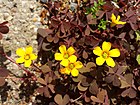Note: This is a project under development. The articles on this wiki are just being initiated and broadly incomplete. You can Help creating new pages.
Difference between revisions of "Oxalis corniculata - Changeri"
(→External Links) |
(→List of Ayurvedic medicine in which the herb is used) |
||
| Line 45: | Line 45: | ||
==List of Ayurvedic medicine in which the herb is used== | ==List of Ayurvedic medicine in which the herb is used== | ||
| − | + | * [[Changeri ghrita]] | |
| + | * [[Jivantyadi ghrita]] | ||
| + | <ref name="Ayurvedic preparations"/> | ||
==Where to get the saplings== | ==Where to get the saplings== | ||
Revision as of 12:11, 11 June 2019
Changeri, is a herbaceous creeping plant. The leaves are bright green and trifoliate, flowers are bright yellow. The whole plant is edible and has a very sour taste.
Contents
- 1 Uses
- 2 Parts Used
- 3 Chemical Composition
- 4 Common names
- 5 Properties
- 6 Habit
- 7 Identification
- 8 List of Ayurvedic medicine in which the herb is used
- 9 Where to get the saplings
- 10 Mode of Propagation
- 11 How to plant/cultivate
- 12 Commonly seen growing in areas
- 13 Photo Gallery
- 14 References
- 15 External Links
Uses
Scurvy, Antidote for poison, Fever, Inflammation, Insomnia [1]
Parts Used
Chemical Composition
Common names
| Language | Common name |
|---|---|
| Kannada | hulichikka, changeri gida |
| Hindi | mrul, amrulsak, anboti, chuka tripati |
| Malayalam | puliyaral, puliyarala |
| Tamil | puliyancirukirai, puliyankirai, puliyarai, puliyarani |
| Telugu | pulichinta, pulichintaaku, ambotikura |
| Marathi | NA |
| Gujarathi | NA |
| Punjabi | NA |
| Kashmiri | NA |
| Sanskrit | amlapatrika, changeri, shuklika |
| English | Indian sorrel |
Properties
Reference: Dravya - Substance, Rasa - Taste, Guna - Qualities, Veerya - Potency, Vipaka - Post-digesion effect, Karma - Pharmacological activity, Prabhava - Therepeutics.
Dravya
Rasa
Amla (Sour), Kashaya (Astringent)
Guna
Laghu (Light), Rooksha (Dry)
Veerya
Ushna (Hot)
Vipaka
Amla (Sour)
Karma
Vata, Kapha
Prabhava
Habit
Identification
Leaf
{{Leaf|Trifoliate|Alternate| leaflets 0.5-1.5 x 0.6-2 cm, broadly obcordate, apex emarginate, base cuneate; petioles 1.5-3 cm long.}[3]
Flower
| Type | Size | Color and composition | Stamen | More information |
|---|---|---|---|---|
| Bisexual | Solitary or in axillary umbels | Yellow | 10 | peduncles 4-10 cm long; pedicels 0.5-1 cm long; bracts 2, 3-4 mm long, linear-lanceolate. Sepals 5, 2-3 mm long, ovate-lanceolate. Petals 5, 5-6 x 3-4 mm, ovate-lanceolate. Stamens 10, in two rows. Ovary 5-celled; ovules many; styles 5, distinct |
Fruit
| Type | Size | Mass | Appearance | Seeds | More information |
|---|---|---|---|---|---|
| A capsule | 0.8-1.5 x 0.3-0.5 cm | linear, puberulous outside | seeds many, minute, brown. | {{{6}}} |
Other features
List of Ayurvedic medicine in which the herb is used
Where to get the saplings
Mode of Propagation
How to plant/cultivate
Season to grow
Soil type
Propagation
Commonly seen growing in areas
Tropical area, Sub tropical area
Photo Gallery
References
- ↑ "Uses"
- ↑ "Vernacular names"
- ↑ PLANTS OF KERALA VER.2, N. Sasidharan "BOTANIC DESCRIPTION"
- ↑ Cite error: Invalid
<ref>tag; no text was provided for refs namedAyurvedic preparations
External Links
- Pages with reference errors
- Ayurvedic Herbs known to be helpful to treat Scurvy
- Ayurvedic Herbs known to be helpful to treat Antidote for poison
- Ayurvedic Herbs known to be helpful to treat Fever
- Ayurvedic Herbs known to be helpful to treat Inflammation
- Ayurvedic Herbs known to be helpful to treat Insomnia
- Herbs with Flowers used in medicine
- Herbs with Leaves used in medicine
- Herbs with common name in Kannada
- Herbs with common name in Hindi
- Herbs with common name in Malayalam
- Herbs with common name in Tamil
- Herbs with common name in Telugu
- Herbs with common name in Sanskrit
- Herbs with common name in English
- Habit - Herb
- Index of Plants which can be propagated by Seeds
- Herbs that are commonly seen in the region of Tropical area
- Herbs that are commonly seen in the region of Sub tropical area
- Herbs
- Oxalidaceae
- Ayurvedic herbs that don't have seed photos




